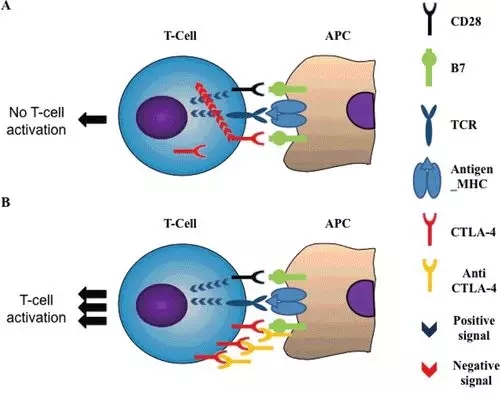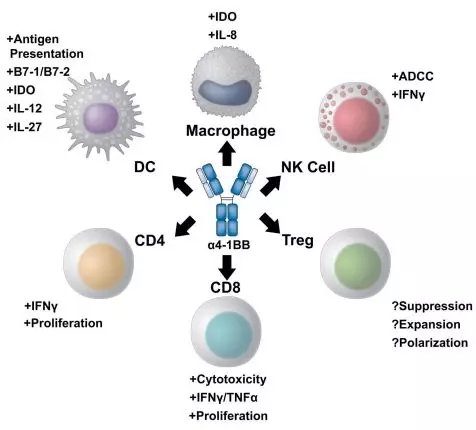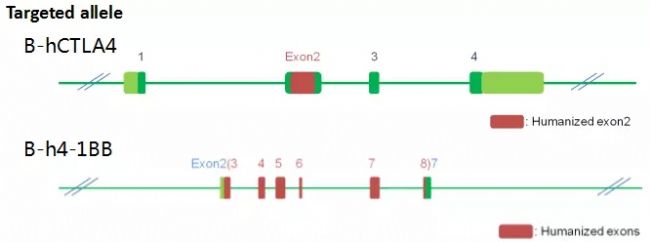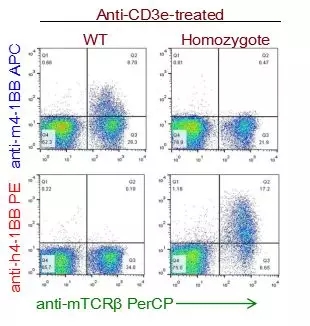
Figure 1. T-Lymphocyte activation requires two signals [1]
4-1BB Â That is, CD137, TNF receptor superfamily member 9 is a member of the TNF receptor superfamily, and is mainly expressed on the surface of activated T cells, NK cells, and monocytes. Activation of CD137 by ligating its ligand CD137L or by activating CD137 monoclonal antibody, it can provide co-stimulatory signals to activate T cells, activate T cells to proliferate and secrete cytokines, and its mediated co-stimulatory signal can induce antigen presentation. The cells proliferate and secrete cytokines.
Many experiments have shown that intervention of CD137 co-stimulation can regulate the function of T cells and antigen-presenting cells to produce anti-tumor immunity, providing a new target for tumor immunotherapy.

Figure 2. A multi-potent role for 4-1BB targeted immunotherapy.[2] Â
4-1BB agonist therapies elicit diverse immune effector responses on both the innate and adaptive immune arms. [2]
B-hCTLA4/h4-1BB mice
The B- hCTLA4/h4-1BB double-sourced mouse independently developed by Biotase provides an effective model and powerful tool for studying the in vivo efficacy of the target antibody drug!
Basic Information 
Shooting strategy 
Protein expression analysis 
Figure 3. Activation and flow cytometry of B-hCTLA4/h4-1BB humanized mouse spleen cells
The results showed that m4-1BB+ cells were detectable in C57BL/6 mice. In B-hCTLA4/h4-1BB homozygous mice, h4-1BB+ cells were detected.

Figure 4. Activation and flow cytometry of B-hCTLA4/h4-1BB humanized mouse spleen cells
The results showed that mCTLA4+ cells were detectable in C57BL/6 mice. hCTLA4+ cells were detected in B-hCTLA4/h4-1BB homozygous mice.
references
[1] Ester Simeone, Paolo A. Ascierto. Immunomodulating antibodies in the treatment of metastatic melanoma: The experience with antiCTLA-4, anti-CD137, and anti-PD1. Journal of Immunotoxicology, 2012; 9(3): 241–247
[2] Todd Bartkowiak, Michael A. Curran. 4-1BB agonists: multi-potent potentiators of tumor immunity. Cancer J. 2014 Mar-Apr;20(2):134-40.
百奥赛图
The company is currently located in Yizhuang, Beijing. It has branches in Shanghai Zhangjiang, Jiangsu Haimen and Boston, USA, and has offices in Wuhan, Guangzhou and Chengdu. Where.
Established in the United States in 2008 and successfully operated. In 2009, Beijing Baiao Saitu Headquarters was established, and in 2012, the headquarters was relocated to Beijing Yizhuang Economic and Technological Development Zone.
Bio-Saitu is a high-tech company based on a stable and efficient gene editing technology platform, with model animal customized services, important model animal development and large-scale breeding and supply, in vivo pharmacological efficacy evaluation services, and antibody drug research and development outsourcing services. Biopharmaceutical companies.
The company adheres to the principle of pursuing better human health and aims to provide high quality products and services for new drug research and development.
Scan code to pay attention to the 100 Olympics map to learn more dry goods
Breast Pump Express Cups,Mom Breast Pump,Anti Backflow Breast Pump,Sensitive Touch Screen Breast Pump
NINGBO YOUHE MOTHER&BABY PRODUCTS CO.,LTD , https://www.oembreastpump.com